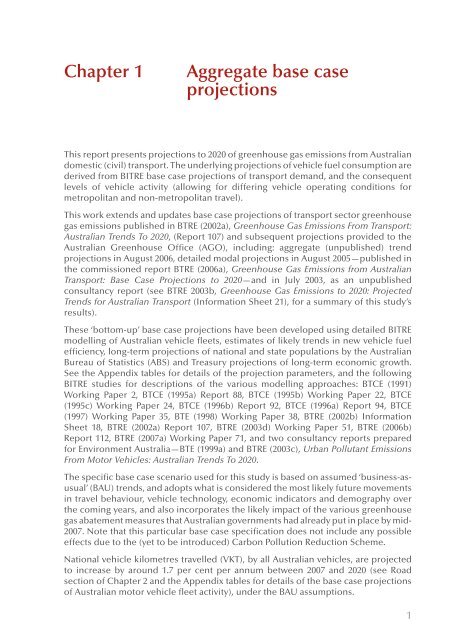PDF: 9795 KB - Bureau of Infrastructure, Transport and Regional ...
PDF: 9795 KB - Bureau of Infrastructure, Transport and Regional ...
PDF: 9795 KB - Bureau of Infrastructure, Transport and Regional ...
Create successful ePaper yourself
Turn your PDF publications into a flip-book with our unique Google optimized e-Paper software.
Chapter 1<br />
Aggregate base case<br />
projections<br />
This report presents projections to 2020 <strong>of</strong> greenhouse gas emissions from Australian<br />
domestic (civil) transport. The underlying projections <strong>of</strong> vehicle fuel consumption are<br />
derived from BITRE base case projections <strong>of</strong> transport dem<strong>and</strong>, <strong>and</strong> the consequent<br />
levels <strong>of</strong> vehicle activity (allowing for differing vehicle operating conditions for<br />
metropolitan <strong>and</strong> non-metropolitan travel).<br />
This work extends <strong>and</strong> updates base case projections <strong>of</strong> transport sector greenhouse<br />
gas emissions published in BTRE (2002a), Greenhouse Gas Emissions From <strong>Transport</strong>:<br />
Australian Trends To 2020, (Report 107) <strong>and</strong> subsequent projections provided to the<br />
Australian Greenhouse Office (AGO), including: aggregate (unpublished) trend<br />
projections in August 2006, detailed modal projections in August 2005—published in<br />
the commissioned report BTRE (2006a), Greenhouse Gas Emissions from Australian<br />
<strong>Transport</strong>: Base Case Projections to 2020—<strong>and</strong> in July 2003, as an unpublished<br />
consultancy report (see BTRE 2003b, Greenhouse Gas Emissions to 2020: Projected<br />
Trends for Australian <strong>Transport</strong> (Information Sheet 21), for a summary <strong>of</strong> this study’s<br />
results).<br />
These ‘bottom-up’ base case projections have been developed using detailed BITRE<br />
modelling <strong>of</strong> Australian vehicle fleets, estimates <strong>of</strong> likely trends in new vehicle fuel<br />
efficiency, long-term projections <strong>of</strong> national <strong>and</strong> state populations by the Australian<br />
<strong>Bureau</strong> <strong>of</strong> Statistics (ABS) <strong>and</strong> Treasury projections <strong>of</strong> long-term economic growth.<br />
See the Appendix tables for details <strong>of</strong> the projection parameters, <strong>and</strong> the following<br />
BITRE studies for descriptions <strong>of</strong> the various modelling approaches: BTCE (1991)<br />
Working Paper 2, BTCE (1995a) Report 88, BTCE (1995b) Working Paper 22, BTCE<br />
(1995c) Working Paper 24, BTCE (1996b) Report 92, BTCE (1996a) Report 94, BTCE<br />
(1997) Working Paper 35, BTE (1998) Working Paper 38, BTRE (2002b) Information<br />
Sheet 18, BTRE (2002a) Report 107, BTRE (2003d) Working Paper 51, BTRE (2006b)<br />
Report 112, BTRE (2007a) Working Paper 71, <strong>and</strong> two consultancy reports prepared<br />
for Environment Australia—BTE (1999a) <strong>and</strong> BTRE (2003c), Urban Pollutant Emissions<br />
From Motor Vehicles: Australian Trends To 2020.<br />
The specific base case scenario used for this study is based on assumed ‘business-asusual’<br />
(BAU) trends, <strong>and</strong> adopts what is considered the most likely future movements<br />
in travel behaviour, vehicle technology, economic indicators <strong>and</strong> demography over<br />
the coming years, <strong>and</strong> also incorporates the likely impact <strong>of</strong> the various greenhouse<br />
gas abatement measures that Australian governments had already put in place by mid-<br />
2007. Note that this particular base case specification does not include any possible<br />
effects due to the (yet to be introduced) Carbon Pollution Reduction Scheme.<br />
National vehicle kilometres travelled (VKT), by all Australian vehicles, are projected<br />
to increase by around 1.7 per cent per annum between 2007 <strong>and</strong> 2020 (see Road<br />
section <strong>of</strong> Chapter 2 <strong>and</strong> the Appendix tables for details <strong>of</strong> the base case projections<br />
<strong>of</strong> Australian motor vehicle fleet activity), under the BAU assumptions.<br />
1

















